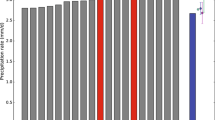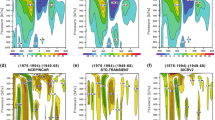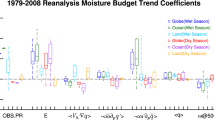Abstract
The scaled-decomposed atmospheric water budget over North America is investigated through the analysis of 25 years of simulation by the Canadian Regional Climate Model (CRCM) driven by the NCEP–NCAR reanalyses for the period 1975–1999. The time average and time variability of the atmospheric water budget for the winter and summer seasons are decomposed into their large-scale and small-scale components to identify the added value of the regional model. For the winter season, the intra-seasonal transient-eddy variance is the main temporal variability. The large- and small-scale terms are of the same order of magnitude, and are large over both coasts and weak over the continent. For the summer season, the time–mean atmospheric water budget is rather different to that of winter, with maximum values over the south-eastern part of the continent. The summer intra-seasonal variance is about twice stronger than in winter and also dominates the variability, but the inter-monthly variance is non-negligible and can be in part associated to North American Monsoon System. Over the continent, the intra-seasonal climatological variance is dominated by the variability of the small scales. The small scales, that is those scales that are only resolved in the regional model but not in the reanalyses, contribute to the added value in a regional climate simulation. In the winter season, the added value of the CRCM is large and dominated by oceanic forcing, while in summer, it is dominant (larger than the large scales) and controlled mainly by convective processes.
















Similar content being viewed by others
References
Berbery EH, Fox-Rabinovitz MS (2003) Multiscale diagnosis of the North American Monsoon System using a variable-resolution GCM. J Clim 16:1929–1947
Bielli S, Laprise R (2006) A methodology for the regional-scale-decomposed atmospheric water budget: application to a simulation of the Canadian Regional Climate Model nested by NCEP–NCAR reanalyses over North America. Mon Weather Rev 134:854–873
Boer GJ (1982) Diagnostic equations in isobaric coordinates. Mon Weather Rev 110:1801–1820
Caya D, Laprise R (1999) A semi-implicit semi-Lagrangian regional climate model: the Canadian RCM. Mon Weather Rev 127:341–362
Davies HC (1976): A lateral boundary formulation for multi-level prediction models. Q J R Meteorol Soc 102:405–418
Denis B, Côté J, Laprise R (2002) Spectral decomposition of two-dimensional atmospheric fields on limited-area domains using the discrete cosine transforms (DCT). Mon Weather Rev 130:1812–1829
Higgins RW, Yao Y, Wang XL (1997a) Influence of the North American monsoon system on the US summer precipitation regime. J Clim (10) 2600–2622
Higgins RW, Yao Y, Yarosh ES, Janowiak JE, Mo KC (1997b) Influence of the Great Plains low-level jet on summertime precipitations and moisture transport over the Central United States. J Clim 10:481–507
Jiao Y, Caya D (2006) An investigation of summer precipitation simulated by the Canadian Regional Climate Model. Mon Weather Rev 134:919–932
Laprise R, Caya D, Frigon A, Paquin D (2003) Current and perturbed climate as simulated by the second-generation Canadian Regional Climate Model (CRCM-II) over northwestern North America. Clim Dyn 21:405–421
Peixoto J, Oort A (1992) Physics of Climate. American Institute of Physics, USA, pp 520
Rasmusson EM (1967) Atmospheric water vapor transport and the water balance of North America. I: Characteristics of the water vapor flux field. Mon Weather Rev 95:403–426
Rasmusson EM (1968) Atmospheric water vapor transport and the water balance of North America. II: Large-scale water balance investigations. Mon Weather Rev 96:720–734
Rasmusson EM, Mo KC (1996) Large-scale atmospheric moisture cycling as evaluated from NMC global reanalysis and forecast products. J Clim 9:3276–3297
Roads JO, Chen SC, Guetter AK, Georgakakos KP (1994) Large-scales aspects of the United States hydrological cycle. Bull Am Meteorol Soc 75:1589–1610
Robert A, Yakimiv E (1986) Identification and elimination of an inflow boundary computational solution in limited are model integration. Atmos Ocean 24:369–385
Ropelewski CF, Yarosh ES (1998) The observed mean annual cycle moisture budgets over the central United States (1973–1992). J Clim 11:2180–2190
Trenberth KE (1991) Climate diagnostics from global analyses: conservation of mass in ECMWF analyses. J Clim 4:707–722
Yakimiv E, Robert A (1990) Validation experiments for a nested grid-point regional forecast model. Atmos Ocean 28:466–472
Acknowledgments
This research was supported by the Canadian Foundation for Climate and Atmospheric Sciences (CFCAS) and the Ouranos Consortium. The authors are grateful to the staff of the CRCM Network and Ouranos Simulation Team for their assistance, and to Mr. Claude Desrochers for maintaining an efficient local computing facility.
Author information
Authors and Affiliations
Corresponding author
Appendix
Appendix
Impact of vertical interpolation and time sampling on the reliability of the water budget for a summer month.
Bielli and Laprise (2006) showed that it is essential to use enough pressure levels in the lower troposphere when computing the moisture budget, especially if one wants to look at the added value of the CRCM. The use of a 6-hourly temporal resolution introduces some approximations, but overall the vertical resolution is more important. These conclusions were drawn for a winter month and the temporal resolution issue might be exacerbated in summer in order to properly capture the diurnal cycle of moisture over the continents. In this section, we will evaluate the impact of vertical interpolation and time sampling on the reliability of the water budget for a summer month.
An additional simulation has been made for the month of July 1975 with output archived every time step (15 min). The output data were then interpolated on two sets of pressure levels (17 and 30 pressure levels). Figure 17 shows the moisture flux divergence computed for the 4 different configurations: 17 pressure levels and 6-h output data (P17-6 h), 17 pressure levels and 15-min output data (P17-15 min), 30 pressure levels and 6-h output data (P30-6 h), and 30 pressure levels and 15-min output data (P30-15 min). Contrary to what was expected, the time sampling is not a larger source of error in summer than it is in winter when calculating the mean moisture flux divergence. Indeed, Fig. 17 shows clearly that the biggest discrepancy in the mean moisture flux divergence when comparing with Fig. 9 is due to the lack of vertical resolution in the low levels near the high topography (P17-6 h and P30-6 h). The errors due to vertical resolution in the summer are much larger than in winter, but the errors due to time sampling are smaller. Figure 18 shows the spectra of the moisture flux divergence for these four configurations. This figure confirms that for the time–mean part of the moisture flux divergence, the errors due to time sampling are small (purple line vs. cyan or orange lines), and that errors due to vertical resolution in the low levels are worse (red or green lines) in summer than in winter shown by Bielli and Laprise (2006). For the time-fluctuation part of the moisture flux divergence, little differences are noted between winter and summer. Hence errors due to time sampling are small and using 17 pressure levels instead of 30 results in an overestimation of the variance.
Monthly mean vertically integrated moisture flux divergence for July 1975, as simulated by the CRCM, calculated on 17 pressure levels and 6-h output data (P17-6 h), on 17 pressure levels and 15-min output data (P17-15 min), on 30 pressure levels and 6-h output data (P30-6 h), and on 30 pressure levels and 15-min output data (P30-15 min)
Rights and permissions
About this article
Cite this article
Bielli, S., Laprise, R. Time mean and variability of the scale-decomposed atmospheric water budget in a 25-year simulation of the Canadian Regional Climate Model over North America. Clim Dyn 29, 763–777 (2007). https://doi.org/10.1007/s00382-007-0266-5
Received:
Accepted:
Published:
Issue Date:
DOI: https://doi.org/10.1007/s00382-007-0266-5






